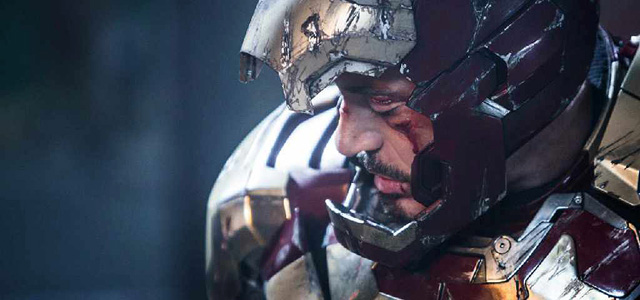(M) Robert Downey Jr., Gwyneth Paltrow, Ben Kingsley, Guy Pearce
Suffering from post-traumatic stress disorder after the events of The Avengers, Tony Stark (Robert Downey Jr.) takes to hiding out in his research and development bunker, using remote controlled Iron Man suits to represent himself to the world.
When his friend and former bodyguard Happy Hogan (Jon Favreau) is seriously wounded in a terrorist attack, Stark declares his intent to take revenge and makes himself a target for the Mandarin (Ben Kingsley). The Mandarin’s response leaves Stark assumed dead, his home reduced to rubble and his girlfriend Pepper Potts (Gwyneth Paltrow) a captive. Taking advantage of his apparent deceased status, Stark hits the streets to gather information, gains the assistance of a young boy called Harley (Ty Simpkins), and sets out to rescue Pepper.
As the terrorists’ activities accelerate with an audacious kidnapping of the President of the United States, Stark and fellow power suit wearer James Rhodes/War Machine (Don Cheadle) have to take on genetically modified enemies whose astonishing powers make them seem all but invulnerable.
Interestingly, along with some pointed political comments about government collusion and the nature of terrorism the film now must deal with the Marvel universe as it has been laid out in The Avengers. Previously, stand alone character films like Thor and Captain America have built the mythology but this film operates in the post-Avengers universe, the first stand-alone character film that has tackled this.
As such, there are some comments about the fact that the world has changed since the arrival of “the big guy with the hammer” and some third-act heroics by Iron Man seem a little odd in that he could have called on the help of other super heroes.
Cleverly though, the film goes back to 1999 to find it’s villain and bring him back into Stark’s life, in the process threatening everything he knows and loves.
Writer/director Shane Black ensures that Robert Downey Jr. has a steady supply of his trademark wisecracks, and that there’s plenty of CGI-enhanced action to keep the audience happy.
Black’s take on Iron Man strips the character down to his most vulnerable, and the wise-cracker’s cracks are more visible than ever before. Producer Kevin Feige asserts that this is intentional; that the filmmakers always wanted to put Tony Stark ‘back against the wall, back in the metaphorical cave from the first movie.’
Black’s masterstroke is to first show us how dependent the traumatised Stark is on his iron cocoon, then to force him to spend most of the film operating without it. In amongst the symphony of explosions, DNA-bending bad guys, and a terrorist plot against the heart of American democracy, there’s a backbeat that keeps asking us to question the relationship between the man and the suit. This is Iron Man – or rather, Tony Stark – at his most vulnerable, and how he responds to his brokenness is possibly the film’s dominant theme.
In a way, Iron Man has always been about brokenness. Integral to the design of Tony Stark’s first metal suit is an electromagnet, powered by the Stark-invented arc reactor. Whether he is in or out of the suit, the magnet and reactor are fitted together into Stark’s chest, keeping shrapnel fragments from moving fatally towards his heart. In physical terms, Stark can’t live without this part of his armour. Emotionally, he’s just as dependent on the whole suit. It’s not just a distraction; it’s a security blanket that he can’t do without.
Gerry Conway, who wrote Iron Man comic books for Marvel, says, ‘Here you have this character, who on the outside is invulnerable, I mean, just can’t be touched, but inside is a wounded figure. Stan [Lee] made it very much an in-your-face wound, you know. His heart was broken, you know; literally broken. But there’s a metaphor going on there. And that’s, I think, what made that character interesting.’
Iron Man 3 marks the beginning of phase two of Marvel’s plans to bring their vast comic book universe to the big screen.
The next two years will see returns for some of the existing Avengers in solo mode, the introduction of Ant Man and, in 2015, a second Avengers outing. Phase three of the project will take us into the 2020s, with a vast universe of inter-related storylines and characters. It amounts to what some commentators have identified as a game-changing approach to blockbuster franchises, growing the brand – and the potential financial return – exponentially.
Adrian Drayton














